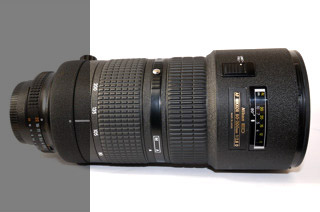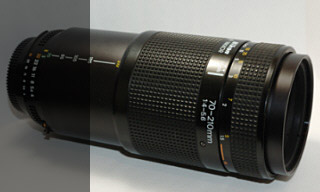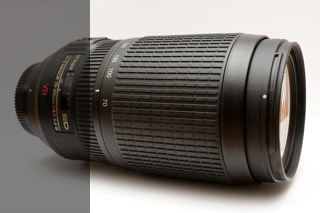AF zoom tele
Nikon, Sigma, Tamron auto focus zooms – tele

Nikon AF 80-200 2.8 push-pull
The AF 80-200 2.8 lens exists in a variety of versions, which sometimes confuses people. The lens exists in four varieties:
- AF Nikkor push pull zoom, rotating ring as focus limiter, about 350 to 400 Euro used in Europe
- AF-D Nikkor push pull zoom, slider as focus limiter, about 400 to 500 Euro used in Europe
- AF-D Nikkor 2-ring for focus and zoom, tripod mount. Recently discontinued version, price 600 Euro (used) or 1000 Euro (new while stocks last) in Europe.
- AF-S 2-ring lens with internal focus motor. Used price: 1000 Euro. Was replaced by the AF-S VR 70-200 2.8 for 2000 Euro new.
The biggest problem with the older push-pull lenses is the lack of the tripod mount. Manfrotto makes an aftermarket tripod mount which is more like a cradle for lens and camera and therefore heavy and bulky. I would not recommend to use the lens on a tripod without a tripod mount. This is a very heavy and bulky lens and you certainly will not take this lens on a vacation. The optical performance of all of these lenses is rofessional grade. The only downside of this optical design is a weakness in close focus perfomance (wideo open aperture and f/4) which eases at a distance of 5 meters. From 150mm to 200mm performance wide open drops a bit (but still very good) and it is recommended to stop down to f/4.

Nikon AF 80-200mm 2.8D 2-ring
Same optical formula and performance as the older push-pull. Improved AF speed compared to non-D push-pull (about 1,5x as fast), tripod mout and 2-ring design like all modern zooms. At current used prices I recommend to skip the older push-pull lens and to go right away for this 2-ring version. The tripod mount is really worth it.

Nikon AF 70-210 4.0-5.6
This push-pull zoom was the mass-market telezoom of it’s time. Basically it is the predecessor of todays 70-300 zooms. Despite the consumer-oriented positioning this zoom it is exceptionally well made, the main lens tube is even made of metal, only the sliding collar is entirely made of plastic. The focus ring in front of the lens is rubberized. Weight is 590g.
This lens is the non-D version which was produced in a much higher quantity than the D-version of the late 90’s. Both lenses have the same optical and mechanical construction, the D-version has the added distance chip an features much quicker focussing. If you can live with the slower focussing performance of the non-D lens you can save quite a bit money. Due to several glowing reviews this lens (especially the D-version) skyrocketed in price. The D-lens goes for anything between 150 and 200 Euro where the non-D lens costs about 80 to 100 Euro. Due to the fact that this lens was “just” the every-day-consumer lens in the late 80’s and throughout the 90’s I would not pay more than 100 Euro for such a lens.
Optical performance is good. The lens feels and and handles like a “mini-push-pull-80-200-2.8” without ever reaching a pro-level optically. Stopping down one stop is highly recommended, at the long end from 180mm and up f/8 is mandatory as the lens gets softer towards the long end wide open. It’s an ideal travel lens it delivers reasonably good optical performance. The hype that the lens surrounds is a little bit beyond me. It delivers a good, “solid” optical performance, nothing more or less.
Sample (DX): 155mm f8

Nikon AF-S IF-ED VR 70-300mm 4.0-5.6
This class of lenses was originally founded back in the days of manual lenses with the widely popular 70-210mm lenses. Those lenses were transferred in the AF era before the new class of 70-300mm lenses appeared.
After the initial AF 75-300mm lens Nikon offered for almost ten years two different 70-300mm lenses: A more sophisticated 70-300mm AF-D lens which incorporated ED glass and a lesser AF-G version for the masses. When the AF-S ED VR lens appeared in 2006 it doubled as a successor for both first generation lenses and even added VR.
Performance-wise this lens is a big step up from the former consumer offerings. Sharpness drops a bit towards the long end, but not as much as with the older lenses. Some people compare the lens very favourably to professional 70-200mm zooms, but I disagree. There is still a gap in contrast and color compared to the pro-zooms. Still, you get more than you pay for – professional zooms cost several times more.
Samples (FX / 36MP): 300mm f5,6 300mm f7,1

Sigma APO Macro DG 70-300mm 4.0-5.6
Cheap compact travel zoom, make sure to get the slightly more expensive “APO” version with the red ring in front of this lens. It contains glass elements that are the equivalent to the type of glass that Nikon calls “E”. The APO 70-300 is a typical “beginners lens”, lenses of this type are often bought together with the first camera to cover the long end of the zoom range. The Sigma version is better than the non-ED Nikkor and some people claim that this lens is also better than the ED-Nikkor. My sample performs great in the range from 70mm to 200mm, above that the lens gets soft. I would call this lens a “70-240 with a 300mm emergency option”. Image quality does not come close to pro-lenses but it does a good job with enough sunlight.
